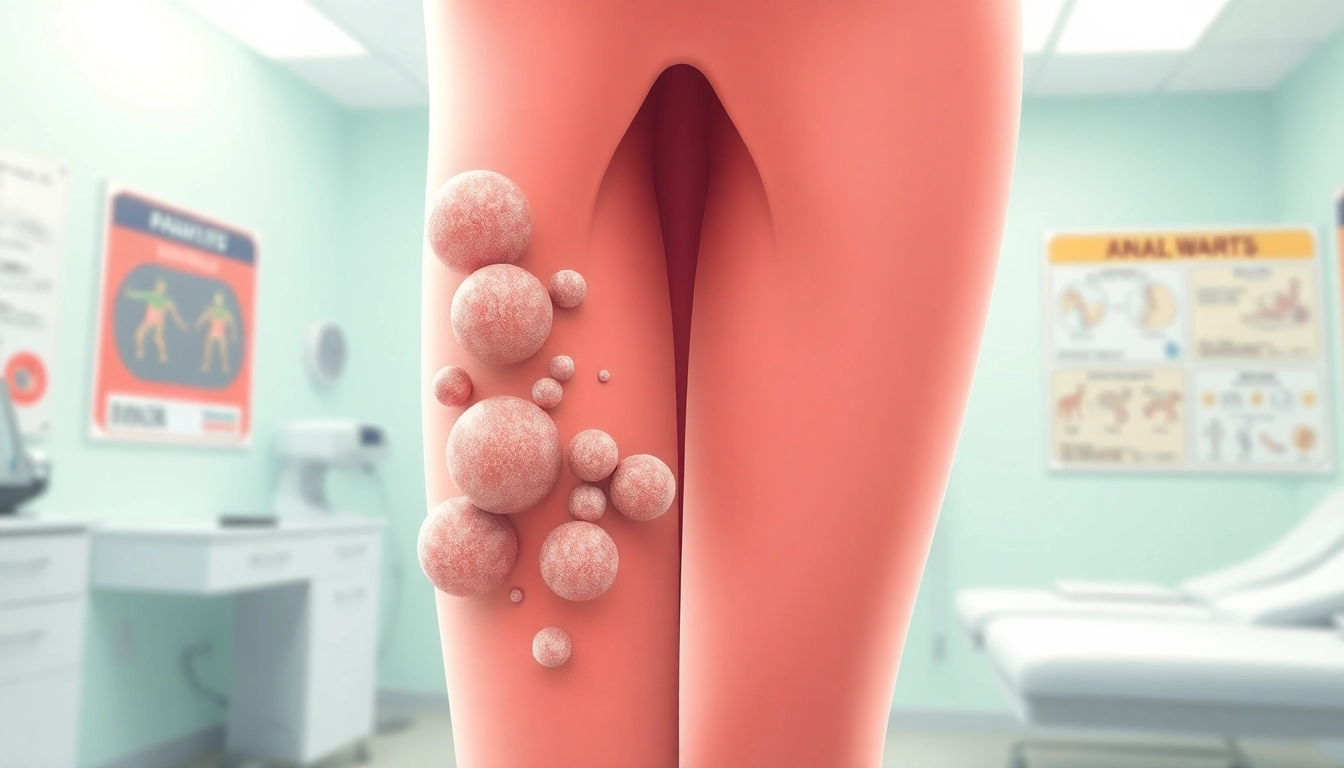
Introduction to Anal Warts
Anal warts, also referred to medically as condyloma acuminata, are small growths that occur around the anus and sometimes within the anal canal itself. These growths are caused by the human papillomavirus (HPV), a highly contagious virus that is primarily spread through skin-to-skin contact during sexual activities. This article aims to provide a comprehensive understanding of anal warts, including their symptoms, causes, treatment options, and prevention strategies. A thorough exploration of these aspects is vital, not only for those affected but also for promoting awareness about this common condition. For more information about Anal warts, read on.
What Are Anal Warts?
Anal warts are benign growths that appear as a result of an infection by specific strains of HPV. These can manifest as small, flesh-colored bumps or larger growths that may appear cauliflower-shaped. They can be located in and around the anal region, and their size can vary significantly. While they are often painless, they can lead to discomfort and itching, prompting individuals to seek medical intervention.
How Common Are Anal Warts?
Research indicates that anal warts are quite common, particularly among sexually active individuals. It is estimated that about 1 in 1,000 adults will experience anal warts at some point in their lives. While the prevalence is notable among those with multiple sexual partners, it can affect anyone who engages in sexual activity, regardless of prior health status. Additionally, the likelihood of acquiring anal warts increases with certain risk factors, such as other sexually transmitted infections (STIs).
The Role of HPV in Anal Warts
HPV encompasses a large group of viruses, with over 150 different types identified to date. However, not all strains lead to the formation of anal warts; primarily, types 6 and 11 are responsible for this condition. It is essential to note that while HPV is often associated with genital warts, certain high-risk strains can lead to more severe conditions like cervical or anal cancer. Regular screening and vaccination against HPV can significantly reduce the risk of complications.
Symptoms of Anal Warts
Identifying Anal Warts
Anal warts can often be identified by their characteristic appearance and location. They may appear as:
- Small, raised bumps on the skin surrounding the anus
- Flesh-colored or slightly darker growths
- Clusters that create a cauliflower-like texture
- Sometimes flat and unobtrusive bumps
In some cases, anal warts can be internal, and may require examination by a healthcare professional for diagnosis.
Related Symptoms & Discomfort
While anal warts can be asymptomatic, many individuals report associated symptoms including:
- Itching or irritation around the anal region
- Bleeding or discharge, particularly during bowel movements
- Feeling of a lump or foreign body sensation in the area
- Pain or discomfort during sexual intercourse
If any of these symptoms are persistent or worsen, it is strongly advised to seek medical evaluation. Early intervention is crucial to prevent further complications.
When to Seek Medical Advice
Individuals who suspect they have anal warts should consult a healthcare professional, particularly if they experience any of the symptoms mentioned above. It is important to differentiate anal warts from other conditions that may present similarly, such as hemorrhoids or fissures. Early consultation can provide clarity, appropriate diagnosis, and timely treatment.
Causes and Risk Factors of Anal Warts
HPV Types and Anal Warts
As mentioned earlier, specific strains of HPV, particularly types 6 and 11, primarily cause anal warts. HPV is primarily transmitted through sexual contact, including anal, vaginal, and oral sex. The virus can live in the skin without causing visible symptoms, which is why many individuals may unknowingly transmit it to others.
General Risk Factors
Several factors can increase the likelihood of developing anal warts, including:
- Multiple Sexual Partners: Individuals with numerous sexual encounters are at a higher risk due to frequent exposure to HPV.
- Weakened Immune System: This can be due to conditions such as HIV/AIDS, which significantly lowers the body’s ability to fight off infections.
- Other STIs: The presence of other sexually transmitted infections can facilitate the transmission of HPV.
- Unprotected Sex: Engaging in sexual activities without proper protection, such as condoms, increases the risk of transmission.
Affecting Factors in Diverse Populations
Anal warts can affect individuals across various demographics, but certain populations may experience higher rates. Research indicates that men who have sex with men (MSM) are at increased risk for anal warts and anal cancer. Similarly, individuals who engage in receptive anal sex may be more susceptible due to increased exposure. Educational campaigns targeting these populations can be effective in promoting awareness and prevention strategies.
Treatment Options for Anal Warts
Topical Treatments
Topical treatments for anal warts are often the first line of defense. Healthcare providers may prescribe medications such as:
- Imiquimod: This cream boosts the immune response against HPV and is applied directly to the warts.
- Podophyllin: A chemical that destroys wart tissue when applied correctly.
- Trichloroacetic Acid (TCA): This is applied directly to the warts to assist in their removal.
It is essential to follow medical advice closely when using these treatments, as improper application can lead to adverse effects or incomplete removal.
Procedural Options
For larger or persistent anal warts, procedural options may be necessary. These include:
- Cryotherapy: This method involves freezing the warts with liquid nitrogen, which ultimately causes them to fall off.
- Electrosurgery: This utilizes high-frequency electrical currents to remove warts.
- Laser Surgery: A targeted laser is used to vaporize the warts, making it effective for larger growths.
- Surgical Excision: In severe cases, warts may be surgically removed.
While these methods may provide effective results, they should be performed by a qualified medical professional to avoid complications.
Home Remedies for Anal Warts
Some individuals explore home remedies for anal warts; however, caution is advised as effectiveness can vary and misuse may worsen symptoms. Common home remedies include:
- Apple Cider Vinegar: Known for its acidic properties, some believe it can help shrink warts when applied topically.
- Tea Tree Oil: This essential oil has antiviral properties that may assist in wart treatment; it should be diluted before use.
- Garlic: Believed to have antiviral properties, crushed garlic can be applied locally.
While these remedies may offer some relief, they are not replacements for professional medical treatment. Consulting with a healthcare provider is advised before trying any home strategies.
Prevention Strategies
Preventing HPV Infection
Preventing HPV infection is the most effective way to avoid anal warts. Key strategies include:
- Vaccination: The HPV vaccine is highly effective in preventing infection from high-risk and low-risk HPV types. It is recommended for preteens and young adults, but can be administered up to age 45.
- Consistent Use of Condoms: Using condoms during sexual contact can significantly reduce the risk of HPV transmission, although it does not eliminate the risk entirely.
- Limiting Number of Sexual Partners: Engaging in sexual activities with fewer partners decreases the likelihood of exposure to HPV.
Regular Screening and Check-ups
Regular health check-ups and screening for STIs can help identify any concerns early on. Individuals at higher risk should discuss more frequent screenings with their healthcare provider. This not only assists in early identification of anal warts but also contributes to broader sexual health.
Living with Anal Warts: Support and Resources
Living with anal warts can be challenging, both physically and emotionally. Education and support are crucial for individuals dealing with this condition. Numerous resources are available, including online forums, support groups, and educational websites where individuals can share experiences and find comfort in knowing they are not alone. Seeking guidance from healthcare professionals can also provide clarity and assistance in managing any discomfort.






